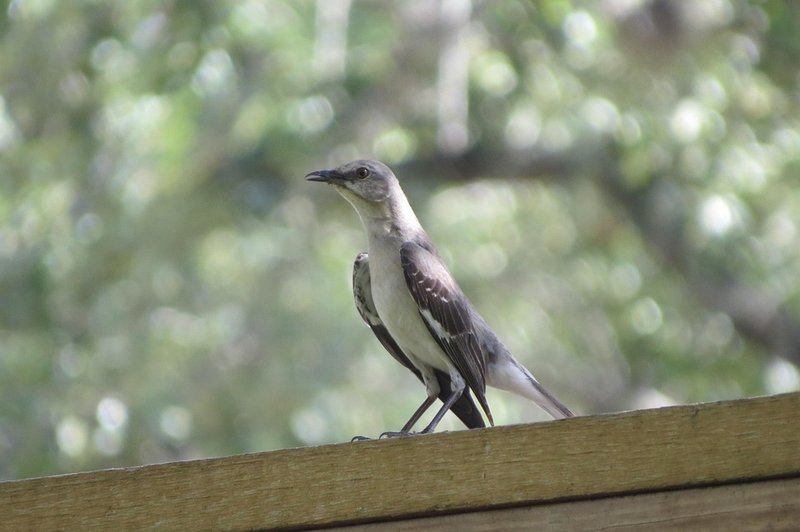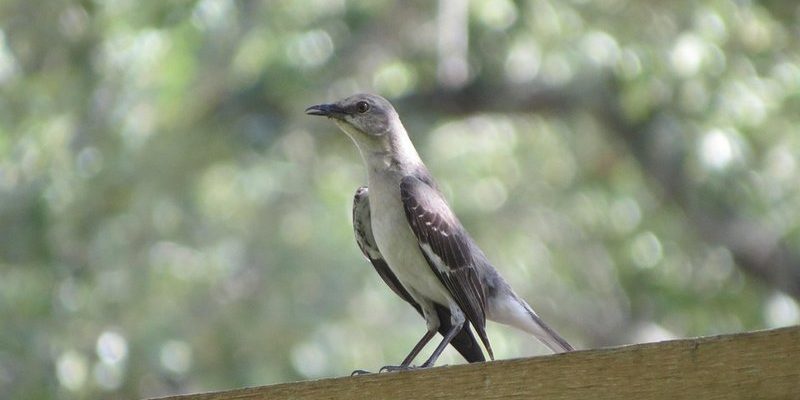
Have you ever heard a bird sing a melody that sounds just like another bird? That’s the mockingbird for you! These fascinating creatures are known for their impressive ability to mimic not only the calls of other birds but also sounds from their environment, including whistles, car alarms, and even human voices. Imagine having a natural talent for karaoke that impresses everyone around you—that’s what mockingbirds do!
Mockingbirds belong to the family Mimidae, and there are about 17 species, with the Northern Mockingbird being the most well-known. These birds aren’t just great singers but are also charming and adaptable, making them a favorite among birdwatchers. Let’s dive deeper into their world and discover what makes these birds so special.
Physical Characteristics of Mockingbirds
Mockingbirds are medium-sized birds, typically measuring around 9 to 11 inches in length. Their bodies are slender, with long tails and long legs, giving them a graceful appearance. One of the most striking features of the mockingbird is its plumage—usually a mix of gray and brown with lighter undersides. This coloring helps them blend into their surroundings, making it easier for them to avoid predators.
Besides their color, mockingbirds have distinct white wing patches that are visible when they fly. These patches are not just for show; they can also help other mockingbirds identify each other. You might notice a mockingbird hopping around your backyard, showcasing its beautiful tail feathers as it flits from branch to branch. It’s their way of announcing their presence and claiming their territory!
Habitat and Range
Mockingbirds are quite adaptable and can thrive in a variety of habitats. You’ll find them in urban areas, parks, gardens, and open fields. They prefer environments with shrubs and trees, which provide shelter and nesting sites. Their range extends across North America, from southern Canada to northern Mexico, with the Northern Mockingbird being a year-round resident in many places.
You might be wondering how they adapt to different environments. Mockingbirds can adjust their diets based on what’s available, eating everything from insects to fruits and berries. In urban settings, they often scavenge for food scraps. This knack for survival is part of what makes them so interesting to observe!
Diet and Feeding Habits
Mockingbirds are omnivores, which means they eat a mix of plants and animals. Their diet consists mainly of insects, fruits, seeds, and berries. During the summer months, they feast on a buffet of insects, which is essential for feeding their young. In the fall, they shift gears and enjoy fruits like mulberries, blackberries, and even grapes. This flexibility helps them thrive in various climates and seasons.
When it comes to feeding, mockingbirds are often seen foraging on the ground or hopping between branches. They have a unique way of locating food; they watch closely and listen for movements in the grass or among the leaves. Sometimes, they’ll even mimic the calls of other birds to distract them while they snatch up a tasty snack!
Behavior and Social Structure
Mockingbirds are known for their vocal talent, and they don’t just mimic any sound—they choose the best ones! A single mockingbird can learn up to 200 different songs throughout its lifetime, often repeating the same tune several times before moving on to another. This impressive repertoire is part of their courtship behavior, as male mockingbirds sing to attract females and establish their territory.
Interestingly, mockingbirds are also quite territorial. Males will defend their space vigorously against other males. They often perform elaborate displays, spreading their wings and tail feathers while singing. This shows off their impressive physical traits and warns rivals to stay away. It’s a classic case of “this is my turf!” that many of us can relate to!
Breeding and Nesting
The breeding season for mockingbirds typically starts in the spring and can last through the summer. Males are usually the first to arrive at the breeding grounds and begin establishing territories. Once they attract a mate, they work together to build a nest, which is typically found in dense shrubs or low trees. The nest is made from twigs, grass, and leaves, providing a cozy home for their eggs.
The female usually lays three to six eggs, which she incubates for about 12 to 14 days. After hatching, both parents take turns caring for the chicks, bringing them food and keeping them safe. It’s a busy time, as the fledglings eventually leave the nest after about two weeks. Watching this whole process unfold can be a rewarding experience for anyone interested in nature!
Interesting Facts About Mockingbirds
| Scientific Name: | Mimus polyglottos |
| Average Length: | 9-11 inches |
| Wingspan: | 12-15 inches |
| Average Lifespan: | 3-5 years in the wild |
| Diet: | Insects, fruits, seeds |
| Notable Behavior: | Mimics other birds and sounds |
Conservation Status
Fortunately, mockingbirds are not currently considered endangered. Their adaptability to different environments has allowed their populations to remain stable. However, like many species, they face threats from habitat loss and urban development. Conservation efforts that focus on preserving natural habitats can help ensure that mockingbirds continue to thrive.
If you want to encourage these beautiful birds in your area, consider planting native shrubs and trees. Providing a welcoming environment can help mockingbirds find food and nesting sites, ensuring future generations can enjoy their amazing songs and charming personalities.
Mockingbirds in Culture and Literature
Mockingbirds hold a significant place in various cultures, often symbolizing joy and creativity. In literature, one of the most famous references is in Harper Lee’s novel “To Kill a Mockingbird,” where the title itself becomes a metaphor for innocence and the importance of protecting the vulnerable. This connection to broader themes serves to remind us of the beauty and complexity of life.
Moreover, mockingbirds have been celebrated in music and art throughout history. Their songs are often seen as a symbol of freedom and expression, resonating with anyone who has ever enjoyed a beautiful day outdoors while listening to their melodies. It’s amazing how a small bird can inspire such profound thoughts and emotions!
Mockingbirds are truly remarkable creatures, showcasing incredible vocal talents and adaptability. Whether you encounter them in your backyard or reading about them in books, they always grab our attention. Their songs not only fill the air with melodies but also connect us to nature in a meaningful way. Next time you hear a mockingbird, take a moment to appreciate its talent and the intricate role it plays in our ecosystem.
FAQ
What makes mockingbirds unique compared to other birds?
Mockingbirds are particularly notable for their incredible ability to mimic various sounds, including the calls of other birds and human-made noises. This talent allows them to communicate effectively with one another and adapt to their environment. Unlike many birds that have a limited range of songs, mockingbirds can keep adding to their repertoire throughout their lives, making them one of the most interesting avian singers out there.
Do mockingbirds migrate?
Most mockingbird species are not migratory, particularly the Northern Mockingbird, which tends to stay in its territory year-round. However, some may move southward during colder months to find more favorable conditions. Generally, their adaptability allows them to thrive in various environments, whether urban or rural, which reduces their need to migrate.
How can I attract mockingbirds to my yard?
Creating a welcoming environment is key to attracting mockingbirds. Planting native shrubs and trees that produce berries can provide food and nesting sites. Additionally, having a birdbath can help them stay hydrated. Ensuring there are open spaces for them to forage will also make your yard more inviting, allowing you to enjoy their beautiful songs throughout the seasons.
Do mockingbirds have any natural predators?
Yes, mockingbirds do face threats from various predators, including cats, hawks, and snakes. Their instinct to blend in with their surroundings helps them avoid detection, but they are not entirely safe. Furthermore, nesting sites are often vulnerable to raccoons and other animals that may raid nests, posing additional threats to their young.
What is the lifespan of a mockingbird in the wild?
In the wild, mockingbirds typically live for about 3 to 5 years. However, some individuals have been known to live longer, especially in protected environments. Factors such as access to food, habitat quality, and predation can significantly impact their lifespan, so it’s essential to consider these aspects when observing mockingbird populations.
Are mockingbirds social birds?
Mockingbirds are generally solitary, especially when it comes to males defending their territories. However, during the breeding season, you might see pairs working together. Outside of the breeding season, they can be seen foraging alone or in small groups, particularly when food is plentiful. Their social behavior can vary based on the environment and availability of resources.
Can mockingbirds learn to mimic human speech?
While mockingbirds are not known for mimicking human speech like some other birds, they can mimic a variety of sounds, including certain tones and whistles that resemble human-made noises. Their impressive vocal abilities allow them to create a wide array of sounds, potentially leading to the impression that they are mimicking human voices. However, it’s more about imitation of sounds they hear frequently in their environment.
What do mockingbirds do during the winter?
During the winter, mockingbirds adapt to changes in food availability by scavenging for whatever is accessible. They may migrate to slightly warmer areas if they need to find more food. However, many mockingbirds remain in their established territories, utilizing their ability to thrive in various conditions. Their resilience helps them cope with colder weather and limited resources.
Are mockingbirds monogamous?
Mockingbirds exhibit a form of monogamy, particularly during the breeding season. Males pair up with females to raise their young, working together to build nests and feed their chicks. However, they may not remain monogamous year-round, as their relationships can change between breeding seasons depending on territorial dynamics and available mates.
Why are mockingbirds considered a symbol of innocence?
Mockingbirds symbolize innocence largely due to their representation in literature, particularly in Harper Lee’s “To Kill a Mockingbird.” The novel portrays the idea that it is a sin to harm those who do no harm, encapsulating the essence of innocence and the protection of the vulnerable in society. This symbolism resonates deeply, making mockingbirds not just birds, but meaningful icons in cultural narratives.

